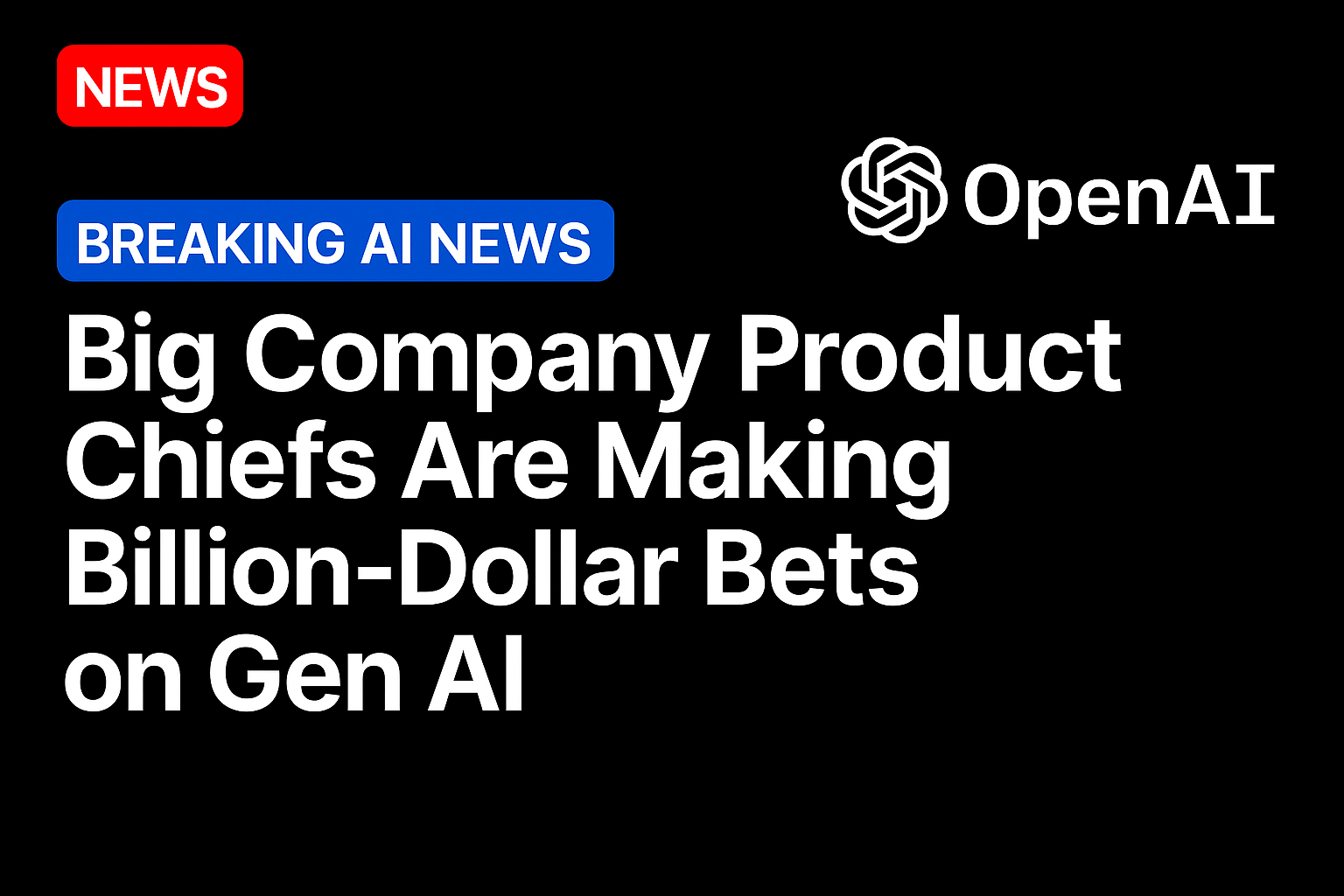A year ago, most chief product officers (CPOs) were still getting a feel for gen AI’s ability to create text, images, video and audio from human inputs underpinning large language models (LLMs). Product leaders had high expectations for the software’s ability to partially automate and streamline labor-intensive tasks ranging from production innovation and production costs to data security and compliance. But few had firmed up plans to fold the technology into their operations. That’s all changed.
Today, nearly all product leaders say they believe gen AI will reshape how they work. Nearly all expect it to streamline workflows within three years. Ninety-five percent say it will sharpen decision making. More than 8 in 10 expect improvements in data security. These figures are up from last year, when 70% expected workflow improvements, 67% anticipated decision-making accuracy gains and half foresaw data security and privacy advantages.
The shift over the past year among CPOs reflects a deeper change in institutional mindset. Gen AI is no longer experimental—it’s strategic. The pressure to deliver more with fewer resources has pushed firms to scale automation of routine, labor-intensive tasks, not just explore how that can be done. Product leaders are now responding with greater optimism, but their sanguine outlook remains tempered by their sense of responsibility for ensuring the technology, when used, is accurate, fair and without biases that skew its outputs.
However, gen AI optimism isn’t evenly distributed.
Tech firms lead in terms of belief and pace of adoption. Forty-four percent of tech product executives now say gen AI’s benefits outweigh its risks, compared to 31% across all other sectors. Tech firms are also more likely to act on their beliefs by testing vendor solutions and pursuing early implementations.
Still, the broader consensus is clear: Gen AI’s role in enterprise product development is effectively now baked in. What remains unsettled is who will shape that future. Half of tech firms identify OpenAI as the leader. However, only one-third of goods firms agree, with another 30% naming Google instead. Services firms prefer Microsoft, but at only 24%, followed by Nvidia and Google, each with 19%. No single provider commands a majority, meaning the larger enterprise AI landscape is still up for grabs.
These are just some of the findings detailed in “From Experiment to Imperative: US Product Leaders Bet on Gen AI,” a PYMNTS Intelligence exclusive report. This edition examines the shifting expectations for gen AI use in enterprise settings. It draws on insights from a survey of 60 chief product officers and heads of product at firms with at least $1 billion in revenue last year. Focusing on projected outcomes, perceived risks and evolving vendor preferences, the survey was conducted in June 2025.
- Gen AI Expectations Surge Across Enterprise Product Teams
- Tech Sector Dominates on Gen AI Risk-Reward Confidence
- Vendor Preferences Split by Industry and Use Case
- Read More
- Methodology
Gen AI Expectations Surge Across Enterprise Product Teams
Product leaders now expect real returns, not just pilot results.
Over the past year, expectations for gen AI’s positive impact on enterprise operations have risen. This rise signals a fundamental shift from cautious experimentation to strategic commitment. In March 2024, enterprises anticipated that the technology would positively affect decision-making accuracy, internal workflows or data security to the tune of 67%, 70% and 50%, respectively. By June 2025, those projections had surged across the board, with many now approaching near-unanimous confidence levels.
Workflow optimization stands out as the area of most agreement. Some 98% of product leaders now expect gen AI to improve internal processes—an increase from 70% last year. Similarly, expectations for enhanced decision making have nearly doubled to 95% from 67% in March 2024. These gains reflect growing belief in gen AI’s role as a core operational lever, not just a peripheral tool.
Security and compliance saw some of the steepest gains. The share of enterprises expecting improvements in data security spiked to 83% from 50%. Expectations for better regulatory compliance jumped to 85% from 47%. Gen AI is now framed less as a risk vector and more as an engine for improving efficiency, control and visibility in business operations.
The heightened assessments were broad-based across other operational categories. For instance, expectations for improvements in customer experience spiked to 93% in June 2025 from 70% in March 2024. Market adaptability surged 97% from 55%. Perceived benefits in business expansion soared to 93% from 67%.
Across areas like staffing, production costs and fraud detection, confidence levels increased by 25 percentage points, to 87% in June 2025 from 62% 15 months earlier. Product leaders now see gen AI not only as a pathway to innovation, but as a pressure-tested lever for efficiency, accuracy and growth.
https://e.infogram.com/ca25a59a-8b5e-4d45-b079-33664e77a15b?src=embed&embed_type=responsive_iframe
Tech Sector Dominates on Gen AI Risk-Reward Confidence
Tech CPOs see more upside—and are moving faster to seize the opportunity.
Confidence in gen AI’s value proposition is rising across industries, but no group is more bullish than tech-sector product leaders. As of June 2025, 44% of tech CPOs say the technology’s benefits outweigh its ethical concerns. This is more than double the share in the services sector (20%) and well ahead of the goods sector (33%) and full sample average (31%).
Still, most executives remain measured in their outlook. Across the full sample, 69% say gen AI’s benefits and ethical concerns are roughly equal. Among services firms, that share climbs to 80%. This rise suggests a more reserved posture by a sector focused on protecting its reputation and credibility before consumers. Even in the goods segment—where optimism runs higher—two-thirds still frame the benefits and risks as evenly balanced.
Tech stands apart. Its leaders aren’t just more confident—they’re increasingly moving with intent. Their 44% benefit-first stance likely reflects stronger familiarity with AI tools, shorter iteration cycles and the organizational models needed for agile deployment. That posture is translating into faster pilots, broader vendor engagement and earlier deployment.
This divergence matters. Tech firms moving to operationalize gen AI are better positioned to shape internal standards, influence vendor priorities and define early benchmarks for success—all outcomes that can fuel widespread adoption across other industries. By contrast, sectors still weighing trade-offs may forgo speed in exchange for certainty, but they risk falling behind as gen AI tools evolve at lightning speed.
What starts as a difference in risk appetite may evolve into a structural divide—one that determines which companies will lead as enterprise gen AI adoption accelerates.
https://e.infogram.com/b89763ef-194b-4b2d-bc56-bd9e68eac012?src=embed&embed_type=responsive_iframe
Vendor Preferences Split by Industry and Use Case
There’s no clear leader yet as firms back different gen AI providers for different goals.
The gen AI vendor landscape remains fragmented, with no single provider earning a majority market share across sectors. Instead, the preferences of corporate users vary widely by industry, reflecting differing priorities around deployment style, institutional readiness to change, data needs and technical integration requirements.
OpenAI, the maker of ChatGPT, leads in overall visibility, driven almost entirely by its dominance in the tech sector. Half of tech firms name the company as their preferred gen AI provider, compared to one-third of goods firms and just 4.8% of services firms. OpenAI’s early lead in prompt-based LLMs, the beating heart of gen AI, and developer-first tools likely explain its traction with product-led teams.
Conversely, services firms gravitate toward giants known for their ability to integrate a variety of tools across enterprises. Microsoft has captured 1 in 4 services firms. Rival Amazon AWS (Amazon Web Services) comes in 10 percentage points behind, at 14%. Nvidia registered 19% among services firms—well above its share among tech and goods firms—likely due to its infrastructure capabilities and long-standing position in data-rich environments.
Google shows cross-sector strength, capturing nearly 30% of goods companies, 25% of tech firms and 19% in services. It remains one of the only vendors with traction across all three sectors, underscoring its hybrid value proposition of cloud flexibility and AI tooling.
The rest of the vendor market remains highly fragmented. Vendors like Meta, Apple and Mistral each earn low, single-digit support. Apple, in particular, appears to be playing catch-up. The iPhone behemoth has failed to reach double-digit market penetration in any segment.
This fragmentation signals a market in motion. As companies using gen AI prioritize features like fine-tuning, security, vertical specialization and model transparency, provider allegiances will likely remain dynamic—creating room for both incumbents and challengers to shape what “enterprise-ready” gen AI really means.
https://e.infogram.com/5769aa69-c392-4336-bd55-c992317cd940?src=embed&embed_type=responsive_iframe
Source: https://www.pymnts.com/




